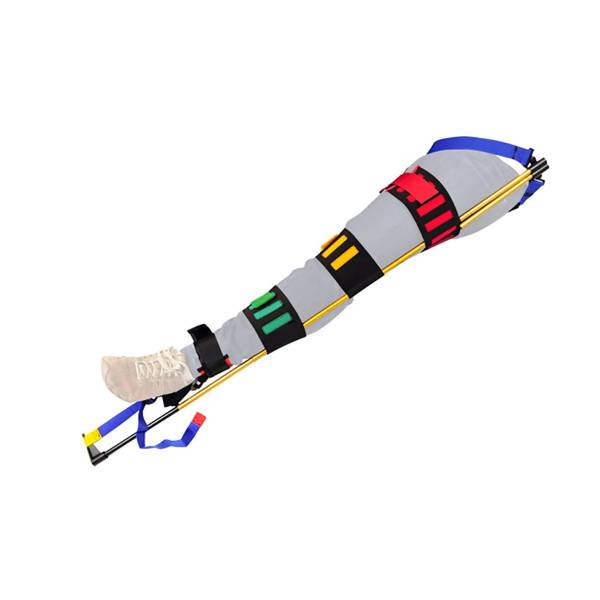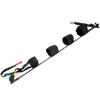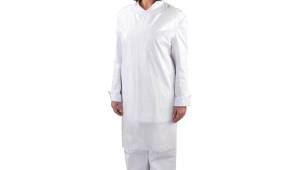Kendrick Traction Device (KTD) — Orange | Adjustable Applicator Splint with Carrying Pouch | Adult, Child or Paediatric Use
We also offer a Kendrick Traction Device in black.
The black Kendrick Traction Device (KTD) allows quick one-person setup, omits the ischial bar for comfort, is adjustable for all ages, and comes with a lightweight carrying pouch. Browse here>>
Revolutionise field care with the Kendrick Traction Device's quick application
The Kendrick Traction Device (KTD) is a compact, lightweight femoral traction device designed for both adult and pediatric patients. It fits easily into a First Aid kit and is perfect for various emergency situations. The KTD simplifies applications by eliminating the need to move the patient, which is crucial in cases involving hip or groin trauma. Its design avoids the use of an uncomfortable ischial bar, enhancing patient comfort and reducing additional pain risks.
The device is also compatible with anti-shock pants, allowing for swift and straightforward application, even in complex scenarios. A single individual can apply the KTD in less than two minutes, making it ideal for urgent situations. The traction pole is adjustable, catering to different patient sizes, from children to adults.
Alongside the device comes a handy storage pouch and easy-to-follow instructions, making the KTD a practical and essential tool in emergency medical kits. Weighing less than 20 ounces, it combines portability with functionality, ensuring readiness and efficiency in critical care.
Browse other evacuation and immobilisation equipment for emergency services, military, first aid, and care.
Visit our
Advanced Life Support Guide
Find everything you need from diagnostics & immobilisation equipment to injection & surgical instruments.
9 reasons to choose the Kendrick Traction Device
- No Ischial Bar: Designed for patient comfort, the KTD eliminates the traditional ischial bar, reducing pressure and pain during application.
- Rapid Application: Can be applied by a single person in under 2 minutes, streamlining emergency procedures.
- Adjustable for All Ages: Equipped with an adjustable traction pole, making it suitable for both adults and children.
- Portable Carry Case Included: Comes with a carry case for convenient storage and transportation.
- Lightweight Design: Weighing just 567g, it's easy to carry in a response bag or vehicle, ensuring portability.
- Colour Variety: Available in both black and orange, catering to different operational preferences.
- Ideal for Emergency Situations: Essential for immobilising and applying traction to unilateral and bilateral femoral shaft fractures, as well as femoral fractures with suspected or confirmed pelvic fractures.
- Contraindications Noted: Not suitable for use with ankle or lower limb fractures or significant knee injuries.
- Intelligent and Compact: A smart, compact design featuring a folding snap-out aluminium pole, colour-coded elastic leg straps, an adjustable ankle hitch, and an adjustable groin strap, enhancing its functionality and ease of use.
What is the Kendrick Traction Device used for?
The Kendrick Traction Device (KTD) is a vital tool in emergency medical care, specifically designed to immobilise and apply traction effectively. It's primarily used in the following situations:
- Unilateral Femoral Shaft Fractures: For fractures occurring on one side of the femoral shaft, the KTD provides essential support and stabilisation.
- Bilateral Femoral Shaft Fractures: In cases where both sides of the femoral shaft are fractured, the KTD is effective in providing necessary traction and immobilisation.
- Femoral Fractures with Pelvic Involvement: The device is also crucial in situations where femoral fractures occur alongside confirmed or suspected pelvic fractures, offering support while minimising the need for extensive patient movement.
It's important to note the contraindications of the KTD, which include:
- Ankle or Lower Limb Fractures: The device should not be used in cases involving fractures in the ankle or lower limbs.
- Significant Knee Injury: Injuries to the knee that are substantial in nature are also contraindications for the use of the KTD.
The KTD is an intelligent and compact device engineered for the splinting of lower extremities. It comprises a folding snap-out aluminium pole, colour-coded elastic leg straps, an adjustable ankle hitch, and an adjustable groin strap. This design ensures ease of application and adjustability to fit different patient sizes, making it a flexible and effective solution in various emergency scenarios.
How to Use the Kendrick Traction Device (KTD)
- Initial Preparation: Begin by employing all necessary infection control methods. Prepare the Kendrick Traction Device (KTD) for use.
- Patient Communication: Inform the patient about the procedure. Consider and administer appropriate analgesia if necessary.
- Assessment and Exposure: Fully expose the injured leg, examining it for any pedal pulses and motor and sensory functions. Assess the limb for colour, warmth, movement, and sensation.
- Manual Inline Traction: Initiate manual inline traction of the limb as soon as possible and maintain it throughout the application of the KTD.
- Positioning the Upper Thigh Strap: Place the upper thigh strap high into the groin area, ensuring the pole holes are on the outside of the leg. This strap should be positioned as high as possible.
- Measuring the Pole: Align the length of the pole with the leg, ensuring the bottom of the pole extends about one section length below the foot. Adjust the pole's length as needed, similar to adjusting a tent pole.
- Applying the Ankle Strap: Before positioning the ankle strap, apply the yellow Velcro strap just above the knee. This may require tightening after traction is applied. Then, apply the ankle strap, ensuring the padded part sits behind the ankle. Use the green strap to tighten. Place the yellow strap over the pole end and gently apply traction by tightening the red strap until the leg is comfortably under traction and in anatomical alignment. Always check distal perfusion.
- Applying Counter Traction: While pulling the red strap, apply a small amount of counter traction to the KTD.
- Securing with Velcro Straps: Apply the remaining two Velcro straps – the red strap at the top of the thigh and the green strap on the lower leg.
- Releasing Manual Traction: Once the KTD is securely applied, you can release the manual inline traction.
- Using the Boot Hitch (Optional): If you choose not to remove the patient's shoe, use the boot hitch option. Lay the boot hitch strap under the ankle, with the white label inside the strap closest to the boot.
Patient Factors & Considerations:
- Regularly assess the patient's distal neurovascular observations, including pulse, colour, warmth, movement, and sensation (CWMS).
- For compound fractures, dressing and wound care might be necessary.
- Avoid applying leg straps over the knee to prevent misalignment and pain.
- The procedure should always be under the control of the person applying manual traction.
- Once traction is applied manually, do not release it until it's secured with the KTD.
Product Specifications
| Specification | Details |
|---|---|
| Storage Size | 24 cm x 9 cm |
| Weight | 20 ounces (567 grams) |
| Pack Dimensions | 9½” wide x 3½” tall |
| Assembly Time | 2-3 minutes |
Where to use the Kendrick Traction Device (KTD)
The Kendrick Traction Device (KTD) is extensively utilised in various pre-hospital settings, known for its critical role in treating severe leg injuries, especially femoral fractures. Its robust design and functionality make it a preferred choice for emergency medical responders, particularly in scenarios requiring immediate medical intervention outside of hospital facilities.
The KTD is exceptionally valuable in environments like ski patrols, where its compactness and ease of use are of paramount importance. Its popularity is growing among aid rigs across the country thanks to its effectiveness and practical design.
In emergency scenarios where time and resources are limited, the KTD's capability for quick application by a single person, often in less than a minute, is highly beneficial. This feature is especially crucial in remote areas or during outdoor activities where immediate access to medical facilities is not available.
Moreover, the KTD's adaptability for both pediatric and adult patients enhances its versatility, making it a suitable tool for a broad range of emergency situations. The device is particularly designed to minimise further injury risk and ensure patient comfort, eliminating the need for leg-raising and unnecessary rolling of the patient during application.
The History of the Kendrick Traction Device
The Kendrick Traction Device (KTD) is a notable invention of Rick Kendrick, who is also credited with the development of the Kendrick Extrication Device (KED). This innovative traction device is manufactured for SP Services, a company recognised for its commitment to providing high-quality emergency medical equipment.
Rick Kendrick's expertise and pioneering contributions to emergency medical devices have established the KTD as a reliable and essential tool in trauma care. The collaboration with SP Services ensures that the Kendrick Traction Device is produced to meet the highest standards of quality and efficiency, making it a trusted choice in emergency medical care.
Why choose a black or orange KTD?
When selecting a Kendrick Traction Device (KTD), the colour choice – black or orange – plays a significant role based on various practical considerations.
Visability
Orange KTD: The bright, high-visibility orange colour is a hallmark of emergency medical equipment. It's particularly useful in scenarios where easy location and quick use are crucial, such as in search and rescue operations, roadside accidents, or any situation with compromised visibility. Its standout hue is beneficial in outdoor settings or low-light conditions, aiding quick response in emergencies.
Tactical Considerations
Black KTD: Preferred in more tactical environments, the black version of the KTD is less conspicuous and blends seamlessly into environments where a lower profile is crucial. This colour is often chosen by military personnel, law enforcement, and emergency response teams involved in tactical situations like SWAT operations or military fieldwork, where stealth and blending with the environment are essential.
Institutional Preferences
Different organisations or departments may have specific preferences or regulations regarding the colour of their equipment. This could be driven by the need for standardisation, ease of inventory management, or aesthetic preference. For example, fire departments might opt for the orange KTD due to its high visibility, while police departments may prefer black to align with their standard gear.
Identification and Organisation
Utilising different colours can significantly aid in the quick identification of specific equipment. In scenarios where multiple pieces of similar-looking gear are present, colour differentiation plays a vital role in efficient organisation and deployment during emergencies. It ensures that the right equipment is readily accessible and used correctly.
Choosing between a black or orange KTD thus depends on the specific requirements of the operational environment, institutional policies, and personal or organisational preferences. Each colour has it's distinct advantages, catering to different scenarios in emergency medical care.
Frequently Asked Questions
The KTD is primarily used for immobilising and applying traction to femoral fractures, especially in pre-hospital settings.
Yes, the KTD is adjustable and can be used effectively for both adult and pediatric patients.
The device can typically be applied by a single person in under two minutes.
Yes, the KTD is available in both black and orange, catering to different operational needs and preferences.
The orange KTD is highly visible, making it ideal for use in outdoor or low-light conditions and in scenarios like search and rescue operations.
The orange KTD offers high visibility, making it a preferred choice in scenarios where quick identification and use are crucial, such as in search and rescue operations or emergency medical services.
Yes, its lightweight design and compact size make it easy to store in emergency kits and carry in various settings.
No, the KTD is designed explicitly for femoral fractures and is not intended for use in tibia and fibula fractures.
Always assess the injured limb for neurovascular status and ensure the device is not used on patients with ankle or significant knee injuries.
The KTD is manufactured for SP Services by Rick Kendrick, the original inventor of both the KTD and the Kendrick Extrication Device (KED).













































